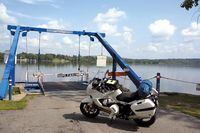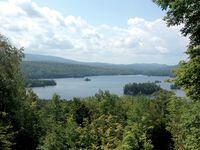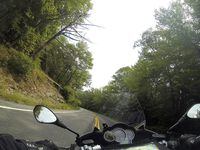The trip announced its future listing in the register of transcendent rides just a couple of hours in, as New York Route 30 unspooled along the western shore of Sacandaga Lake, southernmost of the Adirondack Park's extravagance of lakes. I had not been thinking of anything for a very long time, which I realized only when a thought occurred: If only this ride could last forever… Heading north, I'm hoping never to turn south again. Well, I would not face that inevitability for four days. For now I could pretend there was only road ahead.
The so-called Blue Line—boundary of the 6.1 million-acre park, largest in the contiguous United States—is invisible, yet crossing it feels visceral: As soon as you enter, you have changed climates, or continents, or epochs. The barometric pressure shifts. All of a sudden, you are riding into history.
I was, both oddly and appropriately, doing so on a motorcycle from Europe's longest continuously producing manufacturer. The 2014 Moto Guzzi Norge, on which I entered our largest National Historic Landmark, is a sport-tourer whose bloodlines stretch back to 1928. It is not easy to imagine the ride taken by Giuseppe Guzzi that year to promote the fully sprung 500 Gran Turismo developed with his brother Carlo. The advance it represented would soon be universally adopted, but the public initially declined an enthusiastic embrace of the first swingarm-equipped motorcycle. A showy proof of its worth had thus to be devised: a long, lonely one. And so Giuseppe left Mandello del Lario on the genteel shores of Lake Como. Four weeks of rocky road later, he glimpsed the Barents Sea beyond the cliffs of Norway's North Cape; he had traveled some 4,000 miles to the Arctic Circle. Without heated grips.
I was absurdly coddled by comparison, but it was an adventure nonetheless. It is always an adventure on a Guzzi, even one with a wide, cushy saddle. There is an exchange rate for every world economy, and that of the fully modern motorcycle is this: The inscrutability of what lies beneath the impossible-to-detach fairing pays fair and square for a ride so smooth that to cavil about it is like demanding to unsee the swimsuit issue after discovering it's been Photoshopped. Impossible, and unwished for anyway.
I would never dream of complaining—not when I've been given the kind of gift that is bestowed only in the realm of the motorcycle. This is scientific fact, laboratory proved. Over and over I have been the recipient of stunning largesse: now on the roads of northern New York I receive again, in the form of an opportunity to experience the shivery paradox of a machine that disappears beneath you—daunting 600-pound weight vanishing under power so that the rider might as well be skating a river of smooth ice—while being delivered to the deeply concrete pleasures of the changing view. Long stretches of unfettered wildness, a 30-second film clip of watery abandon under a bridge, mountains brooding from afar, time slowing long enough to live a few moments in a small-town past, Saturday night at the single-screen movie theater, Sunday morning in the wainscoted solemnity of a clapboard church.
Many of the Italian behavioral tics considered by the Guzziphile one with the experience of loving the marque—love is, after all, blind—are virtually gone. The satisfying chunk of first gear engaging is replaced by a whispered suggestion. CARC technology has nullified the feel of the driveshaft lowering its haunches to spring. And although the instrument panel shows a full array of party lights and enough digital information that it requires toggling between screens to get it all, it is possible to ride for days without minding anything but analog speedo and tach. Just as in the olden days.
Into which we now moved on roads that are also surpassingly beautiful, with their largely unpeopled miles of long sweepers periodically interrupted by lake vistas and little towns. There might be no such thing as a bad road in the Adirondacks, unless, perhaps, that one through the heart of ticky-tack Lake George (the only place in the whole wide park it is wise to avoid, unless you have a taste for the tasteless). It is easy to skirt; you can still ingest a daily dose of nostalgia along the northern shores of Lake George. There you pass a plethora of lakeside motels, the kind that bring back childhood excitements like crinkly wrappers on bathroom glasses and miniature beaches with diving platforms and rowboats for the asking.
This is one kind of history unearthed in profusion in the Adirondacks: the personal. Here are the remnants of an America in which the road trip was the king of vacations, and the peculiarly local gave rise to unique iterations of leisure-time commerce. In most of the park, it is once more as if the country were not headlong becoming the same place, endlessly repeated, with identical corporate outposts lining streets all suddenly inseparable. So it is that you can happen on a roadside extravaganza like Tail o' the Pup, with its picnic tables under striped tents, voluble signage, and playground for the kiddies, meeting the need of wanderers in vacationland for foot-long hot dogs and "lobster clam bake" since 1927. I would have thrown myself out of a moving car if as a child I'd seen its carnival-esque blandishments about to pass out of sight.
Yet it is the area's monuments to arguably more profound aspects of history that are most worth the trip. Fort Ticonderoga was among those circled in ink on my map of northern New York (in an act of defiant sentimentality, I left home without any digital devices beyond those installed, and ignored, on the bike). A French star fort erected beginning in 1754, it changed hands five times during two wars. Somehow more poignant to me is the fact that this place, where one can so vividly imagine the travails of those who fought there, was almost lost to us. The fort was a ruin by 1820, when its stunningly situated garrison grounds above Lake Champlain were bought by the Pell family. Anything could have happened. But chance had it they believed in the importance of preserving history's pivots; theirs would become the country's first such restoration.
From the fort it is a short descent to the water's edge and another historic site, saved this time by need. The cable ferry to Vermont is believed to be the oldest crossing in North America, in operation since 1759 (though not always by way of a 16-ton tugboat engine). I stood in line for the seven-minute crossing, though I was about to embark on more time-travel with my 21st century machine. Next stop: where John Brown's body lies, truly, a-moldering in the grave.
The spot is almost literally in the shadow of the colossal ski jumps built for the 1980 Lake Placid Olympic games. His final prophecy on slavery's eradication—"I, John Brown, am quite certain that the crimes of this guilty land will never be purged away but with blood"—would soon be borne out in more terrible loss than even the militant abolitionist could have foreseen. In 1859 he was put to death, his body brought back to rest in the yard outside his hardscrabble farmhouse in North Elba. It is a haunting place.
Sixty-seven miles farther I came to the opposite extreme of human experience: such luxury that a small village of household staff labored year-round to provide a few weeks' illusion of rustic ease to one family and its guests. That family, of course, would be named Vanderbilt, and this, Great Camp Sagamore at Raquette Lake, only one of the gargantuan homes its wealth built. It lies at the end of a four-mile dirt road, the better to convey the otherworldliness of the familial stash. (The Norge handled the ruts with aplomb, as if the bike knew it belonged in these less-oxygenated reaches of society, where continental attention to styling and finish are properly appreciated—excepting leaky hard bags, of course, since perfection is not of this earth, or at least the part named Italy.)
Relics from every sector of the region's history, from the first aboriginal occupation to its current state as natural playground, are gathered up in Blue Mountain Lake's peerless Adirondack Museum. Not for nothing is it called the Smithsonian of the North, its boat collection alone worth the name. Standing before these lovingly hand-built speedboats and canoes I am struck by their similarity to the artful custom bike: the dynamism of both expresses the essential human drive to negate our rootedness. Even at rest, they speak of speed. The more functionally economical they are, the richer too. These are the ones that arouse nothing less than aesthetic elation. And maybe more than that.
I think about exactly this as I turn south to home, at once melancholy and, yes, elated: It's chemistry that makes us love. Whether riding, another person, a place that gets under our skin, making us yearn to return, it's all the same. Several people had offered their opinions on a "better" touring bike. They might as well propose turning in a spouse for a better one, as surely there are defects in the current model. But we don't ride a category—motorcycles—we ride only one. And the Norge was the one that gave me what I didn't know I wanted until it was over and gone.
When you think you've seen it all, there's Tenerife, Spain's magical resort town in the Canary Islands. Fewer than a million people live on this 1,140-square-mile chunk of rock in the North Atlantic. The climate is mild, the people generous, and the roads are both varied and challenging. A busy, well-traveled road mostly encircles the island, connecting Santa Cruz in the northeast and Adege in the southwest. But you want to explore the roads that lead up to Teide National Park, where the miles of switchbacks lead you to an otherworldly moonscape crossing the inactive volcano. Motorcycle rentals are available near Santa Cruz.
_ —Marc Cook_

















/cloudfront-us-east-1.images.arcpublishing.com/octane/B6XD6LS6IVCQPIU6HXDJSM3FHY.jpg)
/cloudfront-us-east-1.images.arcpublishing.com/octane/ICL63FEDDRDTTMINYICCEYGMDA.jpg)
/cloudfront-us-east-1.images.arcpublishing.com/octane/FCGZHQXRBZFLBAPC5SDIQLVF4I.jpg)
/cloudfront-us-east-1.images.arcpublishing.com/octane/WNOB6LDOIFFHJKPSVIWDYUGOPM.jpg)

/cloudfront-us-east-1.images.arcpublishing.com/octane/X33NU3E525ECRHXLNUJN2FTRKI.jpg)
/cloudfront-us-east-1.images.arcpublishing.com/octane/6KKT5NNL2JAVBOXMZYS5ZO76YA.jpg)
/cloudfront-us-east-1.images.arcpublishing.com/octane/J5RKG5O455GMPGQRF2OG6LRT7A.jpg)
/cloudfront-us-east-1.images.arcpublishing.com/octane/GX2CIZKQVRH2TATDM26KFG2DAE.jpg)
/cloudfront-us-east-1.images.arcpublishing.com/octane/ZWIDYSAKQZHD5BHREMQILXJCGM.jpg)
/cloudfront-us-east-1.images.arcpublishing.com/octane/CYUHJZCTSJCH3MRAQEIKXK7SCQ.jpg)
/cloudfront-us-east-1.images.arcpublishing.com/octane/LKOFINY56FCXJCANJ5M7ZDQUBY.jpg)
/cloudfront-us-east-1.images.arcpublishing.com/octane/4NBPDACMWJH63JQYJVK3QRBDZI.jpg)
/cloudfront-us-east-1.images.arcpublishing.com/octane/KKHQHRR3FJGX7H2IPU6RALMWG4.jpg)

/cloudfront-us-east-1.images.arcpublishing.com/octane/5IOFS5JAE5FOXMNA23ZRAVVYUU.jpg)
/cloudfront-us-east-1.images.arcpublishing.com/octane/CGXQ3O2VVJF7PGTYR3QICTLDLM.jpg)

/cloudfront-us-east-1.images.arcpublishing.com/octane/OQVCJOABCFC5NBEF2KIGRCV3XA.jpg)
/cloudfront-us-east-1.images.arcpublishing.com/octane/OPVQ7R4EFNCLRDPSQT4FBZCS2A.jpg)
/cloudfront-us-east-1.images.arcpublishing.com/octane/YBPFZBTAS5FJJBKOWC57QGEFDM.jpg)
/cloudfront-us-east-1.images.arcpublishing.com/octane/W5DVCJVUQVHZTN2DNYLI2UYW5U.jpg)
/cloudfront-us-east-1.images.arcpublishing.com/octane/C3VIRIAYNZCTJAZNRLREDS3JCM.jpg)
/cloudfront-us-east-1.images.arcpublishing.com/octane/XXWKUKITWRAF3HCJAWGJ25V7BA.jpg)